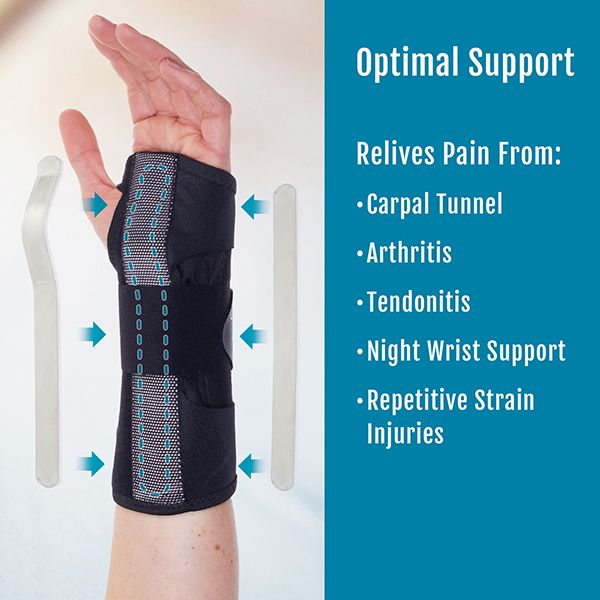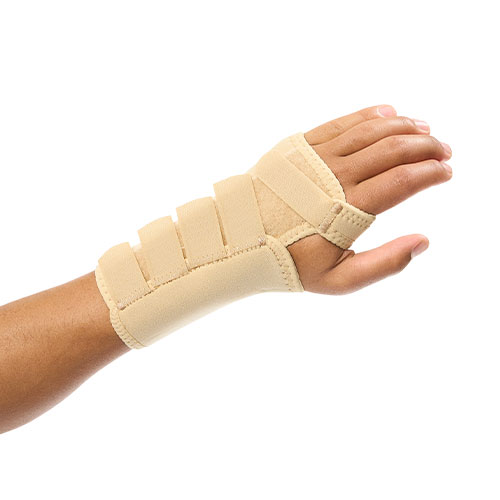The Basic Principles Of Wrist Braces
The Basic Principles Of Wrist Braces
Blog Article
The Main Principles Of Wrist Braces
Table of ContentsLittle Known Facts About Wrist Braces.Wrist Braces - The FactsAbout Wrist BracesWrist Braces Fundamentals ExplainedThe Ultimate Guide To Wrist BracesGetting My Wrist Braces To WorkWhat Does Wrist Braces Mean?
The ManuTrain Wrist Dental braces is adeptly made to resolve the pain and instability related to tenosynovitis, a condition resulting from because of injury or arthritis. This brace stands apart by providing immediate pain alleviation and robust support, making sure both security and comfort for the wrist. Trick Includes: Supplies efficient pain relief Limits strain and provides stabilization Completely adjustable for a personalized fit Crafted from 3D train knit material for breathability and convenience Functions viscoelastic pads for improved pressure alleviation on nerves and blood vessels Aids in the absorption of edema and effusion Adjustable hand remains for targeted stabilization Made to minimize pressure and prevent constriction at the sides The ManuTrain Wrist Brace permits comfy grasping with the thumb and index finger, ensuring marginal irritability throughout usage.
Tendinitis of the wrist, likewise recognized as wrist tendonitis, is the swelling or irritability of the tendons in the wrist. Tendons are the coarse cables that connect muscle mass to bones, making it possible for movement. This condition is typically brought on by recurring pressure or overuse, which can result from activities such as keying, sporting activities, or hands-on labor.
What Does Wrist Braces Mean?
Tendons work as web links between muscles and bones, making it possible for the activities of our joints. Certain to the wrist, these tendons establish the link between the muscular tissues in your lower arm and the bones in your hand and fingers. These tendons are broadly classified right into two types: extensors and flexors. The extensor tendons are positioned at the back of your wrist, allowing it to flex in reverse.
Tendonitis, an inflammatory condition, often tends to take place in one or more of these tendons. Defined as the inflammation or irritation of a ligament, tendonitis typically strikes in areas where tendons overlap or pass over bone, causing irritation. This condition can make wrist activities agonizing, transforming simple activities into resources of discomfort.
Medical diagnosis commonly includes a physical exam where a doctor analyzes pain degrees, swelling, and variety of motion. Imaging examinations like X-rays, MRIs, or ultrasounds might be utilized to rule out other problems and verify inflammation in the tendons. Often referred to as a dull pain, can end up being sharp with motion. There is recognizable swelling and inflammation around the wrist joint.
Some Ideas on Wrist Braces You Need To Know

This support allows the tendons to rest and recover while keeping the wrist in a neutral placement. The support work as a stabilizer, reducing the risk of worsening the injury through everyday activities or accidental movements (Wrist Braces). Among the key advantages of putting on a wrist brace for tendinitis is pain reduction
This not just aids in handling sharp pain but likewise avoids chronic pain that can arise from constant strain on the tendons. In addition, the stress put in by the brace can provide a soothing effect, more alleviating discomfort. A wrist support promotes proper wrist placement, which is crucial for the recovery process.
The brace makes sure that the wrist is maintained in an optimal placement, lowering anxiety on the tendons and promoting faster recovery. This appropriate positioning also aids in avoiding future injuries by urging far better position and ergonomics. Inflexible braces are made to offer optimal support and immobilization. They are typically constructed from stronger and thicker materials and come with a plastic or steel splint.
Wrist Braces Things To Know Before You Get This
The directory strength of these braces restrict nearly all wrist activities, enabling the ligaments to rest completely. Flexible braces, made from soft products such as neoprene or elastic, offer moderate support while enabling some degree of motion. They are perfect for moderate to modest tendinitis and for usage throughout daily tasks.
There are 3 vital points to consider when choosing the best wrist brace: Selecting the ideal dimension is vital for the performance of a wrist brace. It should fit snugly without being too tight, making sure appropriate assistance and convenience. Lots of braces included flexible straps to personalize the fit. Procedure your wrist and seek advice from sizing graphes to choose the suitable brace.
The Best Strategy To Use For Wrist Braces
These need to always be utilized under the guidance of a medical care professional. Way Of Life Alterations: Modifying everyday activities that click here to read might exacerbate your wrist tendonitis is vital.

This area will discover various approaches to managing and treating wrist tendinitis, including both medical and non-medical treatments. From remainder and immobilization to physical treatment and medicine, understanding the available treatment alternatives is crucial for properly dealing with tendinitis and guaranteeing a fast recovery. Relax is a crucial initial step in treating tendinitis of the wrist.
Not known Factual Statements About Wrist Braces
This can indicate taking a break from recurring tasks such as keying, playing musical tools, or engaging in sports. The objective is to allow the irritated tendons to heal without additional irritation. Making use of a wrist brace or splint can dramatically help in the recuperation process by restricting movement and lowering stress on the influenced tendons.
It is very important to select a support that fits well and gives sufficient assistance without being also limiting. Using ice packs to the wrist for 15-20 minutes numerous times a day can reduce inflammation and numb the discomfort. Wrist Braces. Cold therapy is especially reliable in the first phases of tendinitis, as it helps constrict blood vessels and reduce swelling
Things about Wrist Braces
Making use of cozy compresses or a home heating pad assists unwind and loosen the tissues, boosting blood circulation and advertising healing. Heat can also aid eliminate stiffness and enhance the variety of motion in the wrist. Non-prescription NSAIDs such as advil or naproxen are frequently made use of to reduce swelling and ease pain connected with tendinitis.
In situations of severe swelling that do not react to NSAIDs, corticosteroid injections might be provided by a physician. These injections supply powerful anti-inflammatory medication straight to the affected location, supplying considerable relief. However, they are typically made use of sparingly as a result of prospective visit the site negative effects with duplicated use. A physical specialist can develop a specific workout program to improve versatility, strength, and endurance of the wrist.
Report this page